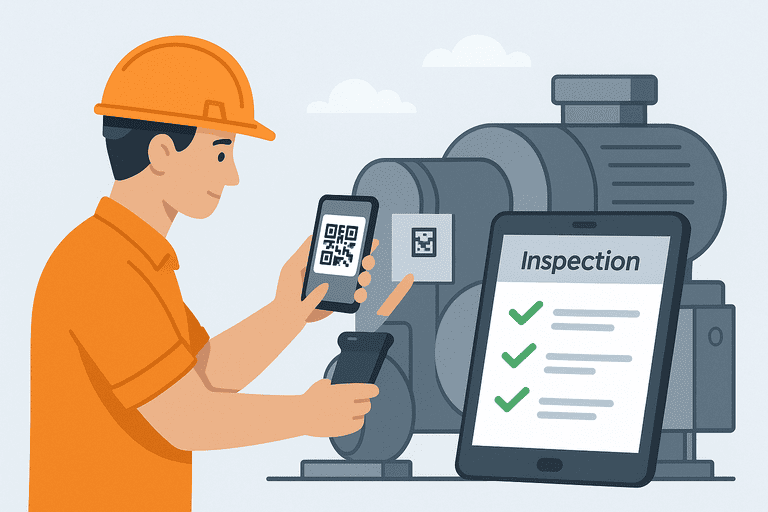The Power of Mobile Inspections — How QR Codes Speed Up Field Work
Learn how QR codes make mobile inspections faster, more accurate, and paper-free — ideal for teams managing assets in the field.

Introduction
In fast-moving industries — from facilities management to construction and coworking — inspections are part of daily operations.
But traditional inspection processes are often slow, paper-heavy, and error-prone.
Technicians jot notes on paper, re-enter them later, and sometimes forget to log updates at all.
The result? Missed maintenance, delayed reporting, and poor accountability.
Enter mobile inspections powered by QR codes — a simple but transformative upgrade that connects field work directly to your digital inventory.
1. Why Traditional Inspections Don’t Scale
Paper forms and spreadsheets might work for small teams, but they break down when:
- Multiple technicians work across different sites
- Inspections need photos or digital signatures
- Supervisors need real-time status updates
- Assets are checked frequently (daily or weekly)
Manual systems create delays and inconsistencies that cost both time and trust.
2. How QR Codes Transform Field Inspections
QR codes bring assets to life.
When a technician scans an asset’s tag, they instantly access and update its record — no searching, no typing.
What QR-enabled inspections enable:
- View maintenance history and condition on site
- Log new inspection data instantly
- Attach photos and comments directly to the record
- Trigger automated alerts or follow-up tasks
No more clipboards or re-typing — just scan, inspect, and sync.
3. Benefits of Mobile Inspections
⚡ Faster Reporting
Data flows directly from the field to the dashboard.
Managers can see inspection results in real time — even before a technician leaves the site.
🧾 Better Accuracy
No more manual entry errors.
Every scan is tied to a specific asset ID, user, location, and timestamp.
📷 Visual Evidence
Technicians can attach photos or videos to inspection logs, creating an audit-ready history.
🔔 Automated Alerts
QR code systems like InvyMate can trigger notifications when an issue is reported — ensuring problems are addressed quickly.
4. Real-World Example — Facility Teams in Action
A facilities management team in Berlin replaced paper checklists with QR-based inspections asset management system.
Before:
- Inspectors carried printed forms
- Reports were submitted at the end of each week
- Updates took 2–3 days to reach management
After:
- Each asset had a QR code
- Inspections updated instantly via mobile
- Weekly reporting time dropped from hours to minutes
Now, managers can spot trends — like recurring failures — and fix root causes early.
5. How to Implement QR-Based Mobile Inspections
- Tag every inspectable asset with a QR code (machines, tools, furniture, vehicles).
- Define inspection templates — what to check and how often.
- Train field teams to scan and submit updates via the mobile app.
- Automate reporting to management dashboards.
- Review data trends to plan preventive maintenance.
The setup takes hours, not weeks — and pays off immediately.
6. Combine Inspections with Preventive Maintenance
When inspection data flows directly into your maintenance system:
- You can spot wear patterns earlier.
- Schedule maintenance automatically.
- Track downtime and repair costs.
This turns reactive fixes into proactive care — saving time and extending asset life.
Conclusion
QR codes make mobile inspections faster, smarter, and far more reliable.
By connecting every inspection directly to your asset database, teams eliminate paperwork, improve accountability, and gain real-time visibility.
Whether you manage 10 or 1,000 assets, mobile inspections are the key to modern, data-driven field operations.
👉 Transform your inspection process with InvyMate —
the all-in-one platform for QR-based asset tracking, mobile inspections, and real-time reporting.